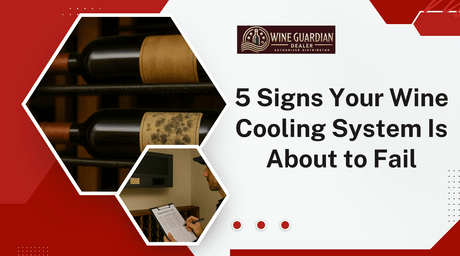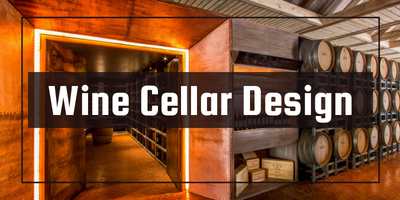
5 Signs Your Wine Cooling System Is About to Fail
Don’t wait for a costly surprise. Wine Guardian Dealer breaks down the top 5 signs your wine cooling system may be failing — and how to fix it before damage...
Jim Hopper
In Stock & Ready to Ship – Order Your Wine Cooling System Today!
Free Wine Cellar Expert Consultation | 📞 Call 1-800-260-1712
Start with a free expert consult—cooling system sizing, racking options, and no upsells.

Build your dream wine cellar—without costly mistakes or guesswork.
By Jim Hopper, Wine Cooling Expert

As wine enthusiasts and cellar system experts, we’ve helped hundreds of collectors—from DIY home builders to commercial restaurateurs—design the ideal storage environment. Whether you're storing a few prized vintages or managing a temperature-sensitive retail inventory, choosing the right cooling system is the foundation of long-term preservation.
Wine is a living product, and even slight fluctuations in temperature or humidity can cause it to age prematurely, spoil, or develop undesirable flavors. The importance of proper cellar climate control cannot be overstated. But with so many options available, one of the most critical decisions you'll face is choosing between a ducted or ductless wine cellar cooling system. Each offers distinct benefits and challenges.
This comprehensive guide — including our full Wine Cooling System Comparisons — will walk you through the differences, advantages, and drawbacks of each type, with real-world scenarios, expert advice, and interactive tools to help you make the most informed decision for your unique space.
Both ducted and ductless air conditioning systems are designed to maintain optimal wine storage conditions (around 55°F and 60–70% humidity), but they differ in how they deliver cooled air and how they integrate into your cellar layout.

A ducted air conditioning system places the cooling unit outside the cellar—in an adjacent mechanical room, basement, or attic. Cool air is delivered via ducts into the cellar, and warm air is returned through a separate duct path.

A ductless air conditioning system has the evaporator mounted directly inside the wine cellar. Air is blown directly into the space without the need for ductwork.
Both systems can be configured as split systems, separating the evaporator (cold side) from the condenser (warm side) for quieter operation and more flexible installation.
Heat pumps are an excellent choice for wine cellars, providing a consistent and controlled environment essential for preserving your collection. Whether you opt for ducted heat pumps or ductless heat pumps, these systems can maintain the ideal conditions for wine storage.
Temperature Control: A key feature of any heat pump is its ability to maintain a stable temperature. For wine cellars, look for a heat pump that can consistently keep the temperature between 55°F and 65°F (13°C and 18°C). This range is optimal for aging wine gracefully.
Humidity Control: Humidity is just as crucial as temperature. A heat pump with a built-in humidistat can help maintain a relative humidity of 50-70%, preventing corks from drying out and labels from peeling.
Air Circulation: Good air circulation is vital to prevent stagnation and ensure a healthy environment for your wine. Heat pumps are designed to circulate air efficiently, maintaining even conditions throughout the cellar.
Energy Efficiency: When selecting a heat pump, consider its SEER (Seasonal Energy Efficiency Ratio) rating. A higher SEER rating means better energy efficiency, which can lead to lower energy bills and a smaller carbon footprint.
Pros:
Cons:
Ducted air conditioning systems are often the go-to choice for collectors who value silence and seamless design. They’re particularly effective in cellars larger than 500 cubic feet, where even air distribution is vital.
Pros:
Cons:
Ductless air conditioning systems are often wall-mounted and can be placed high up to maximize airflow, but their reach is limited. If your cellar has nooks, arches, or multiple zones, a ducted system may provide better consistency.
When deciding between a ducted and ductless heat pump for your wine cellar, it’s essential to understand the key differences:
Installation: Ducted heat pumps require existing ductwork, making them ideal for new constructions or major renovations. In contrast, ductless heat pumps do not need ductwork, making them perfect for retrofits or spaces where installing ducts is impractical.
Energy Efficiency: Generally, ductless heat pumps are more energy-efficient than their ducted counterparts. This is because ductless systems avoid the energy losses associated with ductwork, delivering heated or cooled air directly to the space.
Zoning: One of the significant advantages of ductless heat pumps is their zoning capability. You can control the temperature in different areas of your wine cellar independently, ensuring optimal conditions for various types of wine.
Cost: While ducted heat pumps might have a lower initial installation cost, ductless heat pumps can be more cost-effective in the long run due to their higher energy efficiency and lower operating costs.
Proper installation and maintenance are crucial for the efficient operation of your heat pump. Here are some key considerations:
Location: The outdoor unit should be installed in a well-ventilated area, away from direct sunlight and moisture. This placement ensures optimal performance and longevity.
ductwork: If you’re installing a ducted heat pump, ensure the ductwork is properly sized and insulated. This step is vital to prevent energy losses and maintain consistent temperatures.
Maintenance: Regular maintenance is essential to keep your heat pump running efficiently. Schedule annual maintenance with a qualified technician to check for any issues, clean components, and ensure the system is operating at peak performance.
Heat pumps can be designed to blend seamlessly with your home’s architecture and interior design. Here are some factors to consider:
Indoor Unit Design: Choose an indoor unit that complements your home’s décor. Options include wall-mounted units, which are discreet and space-saving, or floor-standing units that can be integrated into cabinetry.
Outdoor Unit Design: Select an outdoor unit that is compact and discreet. Slim-line or compact units can be easily hidden behind landscaping or other outdoor features.
Color Options: Many heat pumps come in a range of colors to match your home’s exterior. This customization ensures that the unit does not detract from your home’s aesthetic appeal.
By considering these factors, you can ensure that your heat pump not only functions efficiently but also enhances the overall look of your home and wine cellar.
When deciding between a ducted and ductless air conditioning system for your wine cellar, it’s essential to understand the key differences. Use the comparison table below to evaluate which system matches your space and goals:
|
Feature |
Ducted |
Ductless |
|---|---|---|
|
Cellar Size |
Medium–Large |
Small–Medium |
|
Noise Sensitivity |
Minimal |
Moderate |
|
Aesthetic Preference |
Hidden |
Visible |
|
Installation Space |
Needs ducts |
Space-saving |
|
Budget |
Higher |
More affordable |
|
Design Flexibility |
High |
Moderate |
|
Maintenance Access |
Needs planning |
Easily accessible |
🔍 Not Sure Which System Fits Your Cellar? Take our Cooling System Quiz to match your space, budget, and design preferences in just 2 minutes.
Let’s look at how different users solve real challenges when choosing between ducted and ductless systems:
🖊️ Download our Installation Planning Checklist to prep your space the right way.
Cooling systems, especially those involving a central air conditioning system, require proper ventilation for heat rejection. Improper airflow can lead to overheating and system failure. Always ensure the condenser has access to well-ventilated space.
Wine cellars need cool air and controlled humidity. Some ducted systems offer integrated humidification or dehumidification, similar to a traditional air conditioner. However, depending on your region, ductless units may require a separate humidity management tool.
While both systems can be efficient, split ducted systems often deliver higher long-term efficiency due to better heating and cooling control. Ductless systems, being simpler, might offer fewer energy-saving features but also experience less energy loss due to direct air delivery.
Some advanced cooling units (both ducted and ductless) come with Wi-Fi control, mobile apps, and remote diagnostics. If you want remote monitoring for your wine investments, ensure the system supports smart integrations.
There’s no universal best system. The right choice depends on your cellar size, design preferences, budget, and noise sensitivity. Ducted systems offer hidden, quiet performance and flexibility ideal for larger or high-end installations. Ductless systems, on the other hand, simplify installation and are cost-effective for compact spaces or quick retrofits.
Whatever your choice, investing in a quality cooling system ensures your wine matures gracefully and maintains its intended flavor profile.
Still unsure? Talk to a Wine Guardian expert for personalized guidance and quotes.
Ready to find the perfect cooling system for your wine cellar?
Contact us or use our Dealer Locator to get expert help today. Our specialists are here to guide you through every step—from system selection to installation and long-term maintenance.
Ducted systems deliver air via vents from a remote unit; ductless units blow air directly into the cellar from an internal unit.
Ducted systems, since the compressor and fans are located outside the cellar, reducing noise inside the room.
Yes. Especially if ducting isn't feasible or if budget constraints are a concern.
Yes—when sized and installed properly. Ducted split systems may edge out in efficiency over time.
Yes, but it depends on size. Ductless is best for small-to-medium rooms. For high-traffic or large-volume storage, ducted is preferred.
Yes, for ducted systems. Ductless systems can be DIY-friendly but still benefit from expert setup for airflow balance.
🛒Shop our most-loved Wine Guardian cooling systems today.
🛠️Protect your wine with the most trusted systems on the market.
❤️Tested, reviewed, and loved by serious collectors like you.